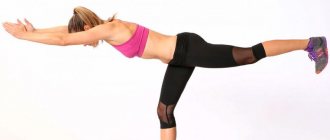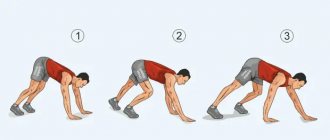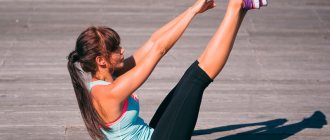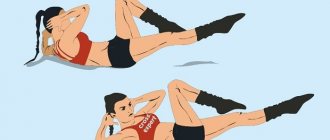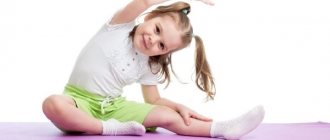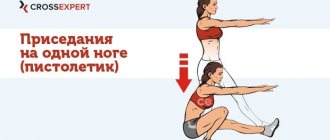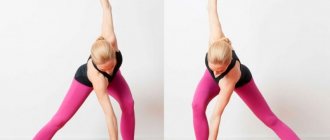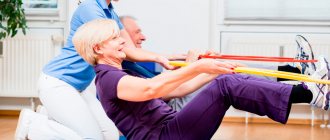The “swallow” exercise, or horizontal balance, is a posture in which a person stands on one leg, straightens the other and lifts it back to failure, tilts the body and spreads his arms to the sides.
This position doesn't look difficult, but it can take weeks to perform it correctly and hold it for more than a couple of seconds. At the same time, the "swallow" develops different aspects of physical fitness, and if you decide to master this pose, you will reap many benefits.
What are the advantages of the “swallow” exercise?
- Develops balance. Holding a pose on one legYoga Balance Workout teaches the body to stabilize and maintain balanceEffect of a 12‑Week Yoga Intervention on Fear of Falling and Balance in Older Adults: A Pilot Study in challenging environments. In the long term, this protects The benefits of balance training from injuries both in sports and in everyday life.
- Strengthens muscles. During the “swallow” exercise, the muscles of the foot, lower leg and front side of the thigh, buttocks and back extensors, and core muscles work.
- Improves flexibility. This exercise gently stretches the muscles at the back of the thigh and develops upper back mobility.
- Relieves back pain. Strengthening the buttocks The effects of gluteus muscle strengthening exercise and lumbar stabilization exercise on lumbar muscle strength and balance in chronic low back pain patients, Core Strength Training for Patients With Chronic Low Back Pain and lower back Effects of lumbar stabilization exercises on the flexion‑relaxation The phenomenon of the erector spinae helps improve posture and biomechanics of movements, which has a positive effect on the health of the spine.
- Corrects imbalance. In double-leg exercises, one limb may take up most of the load, whereas in single-sided movements, both will receive the same amount of work. In the long term, this helps to cope with the imbalance.
Formation of beautiful posture, abs, strong back and arms - the benefits of the horizontal bar for various muscle groups
To achieve a beautiful wide back, a horizontal bar will be your best assistant. In shaping the relief of the torso and back, it is difficult to come up with a worthy replacement in the form of conventional exercises or exercise machines. Ordinary pull-ups can be performed with various grips, however, it is the classic wide or medium grip with the palms facing away that is most effective for pumping up the back. When performing the elements, you should watch your elbows - they should be directed to the sides, but not inward. Pull-ups with a wide grip are even more effective.
When using a horizontal bar, dreams of big and pumped up shoulders will remain just dreams. The bar can only weakly load the anterior and middle shoulder muscles. The dorsal muscles can be slightly pumped with a narrow dorsal grip when doing pull-ups, but the results will not be very noticeable.
How to perform the “swallow” exercise correctly
This exercise does not require special preparation or leading movements. The only thing is that at first, perform the pose next to a wall or chair so that you can stick to it if you lose your balance.
- Bring your legs together and raise your arms to the sides to shoulder level. Take one leg back and place it on your toes.
- Feel how the weight is evenly distributed across the foot of the supporting limb. Straighten both knees, tighten your thighs, glutes and abs, open your chest and lower your shoulders.
- Raise your back leg and at the same time bend at the waist until it is parallel to the floor. Ideally, your free leg should be no lower than horizontal, but if you don't have enough stretch yet, try to reach the highest possible height.
- Pull your chest forward and up, keep your neck straight and shoulders back.
- Do not bend your knees, make sure that your pelvis and shoulders do not turn to the side.
- Hold the pose as long as necessary, and then simultaneously lower your leg onto your toes and straighten your body.
- Repeat on the other leg.
“Swallow” with emphasis on knees and elbows
The next variation of the standard “swallow” is an exercise performed with emphasis on the knees and elbows. This technique allows you to train muscles:
The execution technique includes the following steps:
- Get on your knees and lean on your elbows.
- Straining the muscles of the right (left) leg, slowly stretch it to a position parallel to the floor.
- Then we continue to move the leg higher, reaching an angle of approximately 45 degrees from the parallel of the floor.
- Slowly lower your leg to the starting position. Repeat the exercise.
You need to do 10-12 approaches on each leg.
The following errors may occur during execution: the leg is not raised enough, the knee is bent, the muscles are not tense.
How to complicate the “swallow” exercise
If you can hold the “swallow” for 30 seconds without any problems and do not make technical errors, try the following options.
With my eyes closed
Even if you stand confidently on one leg, the lack of visual information will cause you to stagger. Try to focus on how your foot feels: imagine three points on the edge of the ball and on the heel and keep your attention on this triangle.
On an unstable support
You can try a balance board or BOSU platform. Just be sure to hold onto something to avoid injury if you fall.
On limited support
Performing on a narrow support such as a gymnastic bench, curb or log is essentially no more difficult than a “swallow” on the floor, but at first you will be uncomfortable due to the visual component.
With legs raised forward
This is a combination of the “swallow” with an additional movement - keeping the leg in front. This combination of exercises will be another challenge to your sense of balance and will load more muscles.
Stand up straight, spread your arms to the sides and lift your straight leg forward to the maximum possible height. Stay in this position for a few seconds, and then move this limb back into the “swallow” position. Again, fix the position for a while, move your leg forward, wait a little and lower it.
Make five such bundles on each side. Alternate your legs every other time.
“Swallow” with emphasis on knees and elbows
The next variation of the standard “swallow” is an exercise performed with emphasis on the knees and elbows. This technique allows you to train muscles:
The execution technique includes the following steps:
- Get on your knees and lean on your elbows.
- Straining the muscles of the right (left) leg, slowly stretch it to a position parallel to the floor.
- Then we continue to move the leg higher, reaching an angle of approximately 45 degrees from the parallel of the floor.
- Slowly lower your leg to the starting position. Repeat the exercise.
You need to do 10-12 approaches on each leg.
The following errors may occur during execution: the leg is not raised enough, the knee is bent, the muscles are not tense.
Main groups
All acrobatic exercises can be divided into two large groups - those that are performed dynamically and those of a static nature.
Dynamic exercises
Dynamic acrobatic elements are performed in motion and represent the rotation of the athlete's body. It (as well as turning over the head) can be either complete or partial.
Regarding the presence of support or its absence, inversion occurs:
- with support (somersaults);
- with intermediate support (inversions);
- without support (somersault).
Let's take a closer look at each exercise from the dynamic group:
- Roll. When performing this element, the support alternately touches the support with any rotating part of the body, but turning over the head does not occur. Can be performed with or without bending, alone or in a group, forward, backward and to the sides.
- Somersault. The body consistently turns over its head. This occurs inseparably from the floor and is accompanied by alternate contact of the support with individual parts of the body. Somersaults can be directed forward, backward or to the side. They are carried out solo, in pairs and in a group.
- Movement in an arc or extension. This element is characterized by the fact that the acrobat moves from a lying position to a standing position. Bend at the shoulder blades and place emphasis on them.
- Somersault. This is the name for turning over completely in the air over your head without support. Can be performed solo or in pairs; forward, backward and sideways.
- Half-flip (without full body rotation). Jumping occurs from one part of the body to another: for example, from feet to hands and back.
- Coup. It is performed with a complete inversion over the head, but the supports touch only the limb - arms and legs or only the arms. It can be carried out in a forward or backward direction, standing in one place or moving with a running start.
Did you know? The most significant factor in reducing flexibility
—
This is not the aging of the body, but a sedentary lifestyle when muscles atrophy.
Static exercises
This group contains exercises that are performed without movement, in a static position, and consist of supporting the body so that it takes a certain pose and maintaining its balance.
The static group includes:
- "Leg-split". This is a pose when both legs form one line, or one moves forward and the other back (or both legs move to the sides). Good muscle stretching is required. Performed while sitting on the floor or with the support of a partner.
- "Bridge". The name speaks for itself. You need to bend back in a “bridge-like” arc (using your arms bent at the elbows. Your legs are also bent. Your back “looks” at the floor.
- "Rack". This is the name for a pose when the body is in a static position upside down with emphasis only on the arms or on the arms and head.
It will also be useful for you to learn about the complex of morning exercises, as well as what game stretching is.
Rear horizontal hang
From the title you could already understand that this article will focus on the rear horizontal hang. This wonderful element was mentioned in passing several times, but I decided that a full-fledged article should be devoted to it, since there is a lot of interesting things in it. The back horizontal hang is a gymnastic element that has been introduced into Workout and has taken pride of place in street sports. It is not very difficult, but in order to complete it, you will need to spend some effort and a little time. Or maybe a lot of time... In workout, the back hang also has the name “Swallow”, since there is a certain similarity. A particular similarity can be seen when the legs are spread apart. But enough of the lyrics, let's get down to specifics.
What muscles work
For any exercises on the horizontal bar, you first need strong arms and a well-developed shoulder girdle. For a swallow, strong muscles of the legs and back are no less important.
To perform the swallow, the horizontal bar school does not recommend any special exercises; those that are traditionally used to strengthen and develop strength in the corresponding muscle groups are quite sufficient:
- exercises for pumping the upper limbs and lower back,
- pull-ups behind the back in a reverse grip with legs bent at the knees,
- a simplified version of a swallow with legs wide apart.
More about Mens Physicist
| Technique for performing the plank exercise At first it may seem that the plank is an easy exercise, but this is not so. Not every person manages to hold out for more than 30 seconds at first. The main task of performing the plank exercise is the cumulative tension of the core muscles while supporting your body on your elbows and toes. The sequence of performing the exercise includes several steps. Step 1. Find […] |
| Yoga therapy against SCH Progressive osteochondrosis causes degradation of the vertebrae, joints, ligaments and tendons. The pathology leads to decreased neck mobility and deformation of the intervertebral discs. If left untreated, the disease leads to the development of complications: hernias; protrusions; the appearance of microcracks. Yoga helps to avoid negative consequences. Regular sessions allow you to get rid of risk factors leading to osteochondrosis: physical inactivity; physical stress; injuries; overweight; […] |
| What you definitely need to know Weight in this exercise takes second place, the first place belongs to the correct technique and a smooth trajectory of movement. You must bring your arms together and spread them all the way, this will stretch your pecs and allow more blood to flow into the muscles. At the end point, be sure to keep your hands closed for a couple of seconds; this improves the benefits of the exercise by two […] |
| Exercises for the lower back with a barbell It is worth initially warning a person who suffers from lower back pain that with such symptoms it is not recommended to practice exercises for the lower back with a barbell. If such complaints are not observed, then you can begin loads that will strengthen the muscular frame of the lumbar zone, partially relieving the load from the spine. The bar lies in front of the “athlete”. The back is straight, [...] |
| Half-plough I.P. lying on your back, holding onto a stationary support with straight arms. Raising your legs (straight or slightly bent at the knees) to a level of 90° or more (towards the floor), trying to touch the fixed support with your feet. It is advisable not to touch the floor with your heels when lowering your legs. Raising and lowering your legs while exhaling “Ha-a.” Breathe like a locomotive. Don't think about inhaling, it will happen automatically. Perform the exercise from 10 to 20 repetitions in one series. A larger number is allowed, but without fanaticism. Basic […] |
